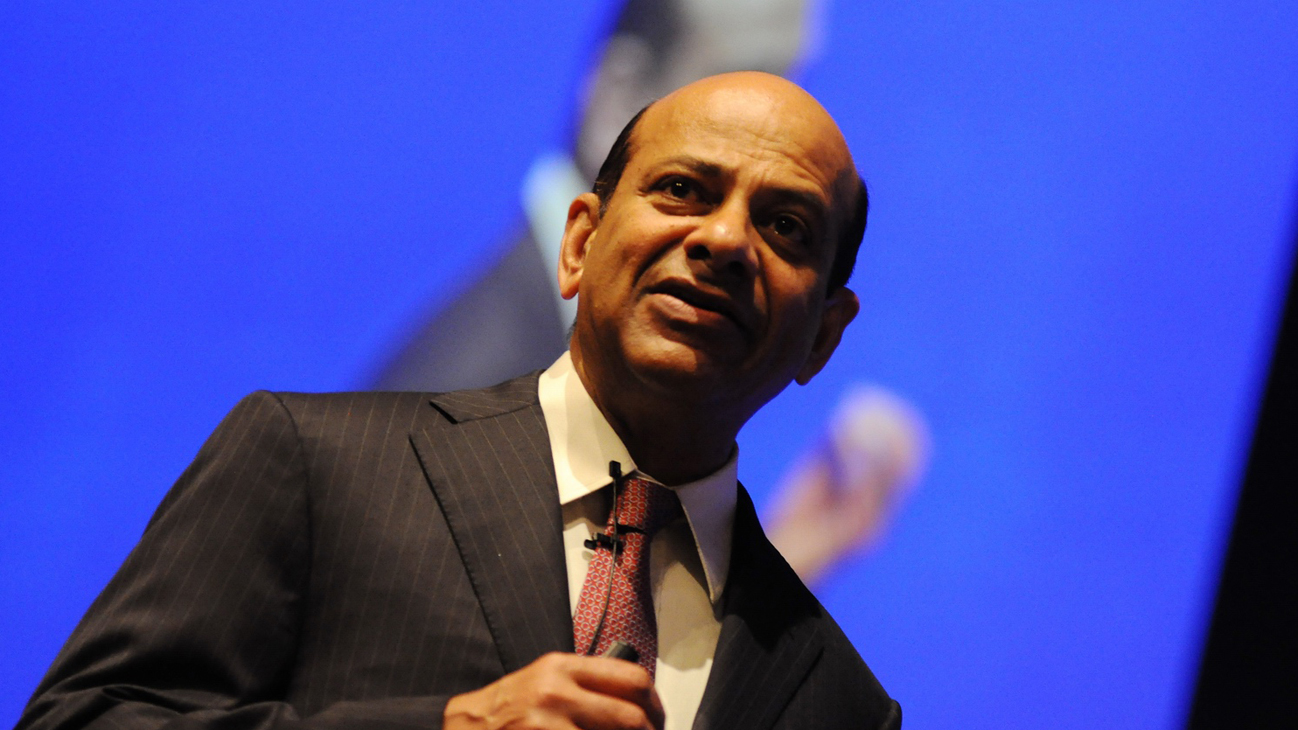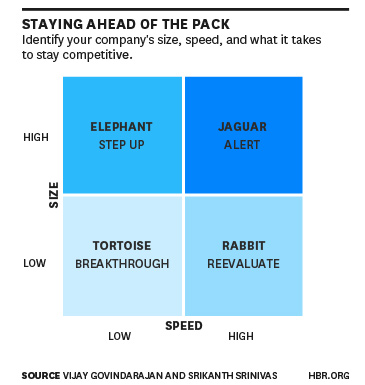Strategic innovation, globalization, and transformation expert Vijay Govindarajan (along with co-writer Srikanth Srinivas) writes on the need for speed in innovation for The Harvard Business Review:
It’s a jungle out there.
While this simple phrase has been used time and time again to discuss the many obstacles people and companies face, an animal metaphor does describe required innovation actions rather effectively.
Imagine a 2×2 matrix with size on the y-axis and speed on the x-axis. Size can be represented as market share, revenue, or units sold, depending on the context. Speed is the speed of innovation of a company relative to the industry. When a company, product, or service is ahead of the competition, speed is high. When it is lagging behind the competition, speed is low.
But why is relative speed so important? Consider a story where two hunters encounter a lion with no ammunition left in their guns. When one starts to run, the other claims the lion will eat him either way. The first replies, “Not as long as I can run faster than you!”
Just like in the jungle, if you are not faster than the competition, you can get eaten up. The key question is, “What actions can be taken to get ahead of the pack?” — to become a jaguar or to stay a jaguar, as you see in the matrix below.
As a tortoise, breakthrough innovation is critical. An all-out effort at breakthrough innovation should be the primary focus. There are no other options available for companies in this quadrant.
As a rabbit, speed of innovation is high, but it is not translating into size, and it is time to reevaluate. Why is the speed of innovation not translating to size? Do we really understand customer value? Is the breakthrough innovation providing a way to leapfrog in cost or performance? If not, why not? Is usability constraining growth? Is the message not reaching across? Is it too complicated? Or are we so far out that customers are having difficulty embracing the idea? If so, what can be toned down without sacrificing value? Or is there need for more education?
An elephant is the most difficult spot to be in. The size has lulled the organization into overconfidence, complacence, and at times, arrogance. This has to be shaken up to re-instill the spirits that brought on the size in the first place. While protecting today, resources must be channeled to bridge the gap and regain the lead. It is time to step up the game.
And while every company, product, or service strives to be a jaguar, even a jaguar has some steps to take. A jaguar has to be alert — very alert. Otherwise, it can easily become tomorrow’s elephant and the day-after-tomorrow’s tortoise. In fast-changing industries, these moves can be extremely swift. Consider the competitive world of smartphones.
Apple’s iPhone was a jaguar. Big, and years ahead of the competition. It got there through a series of breakthrough innovations: the touchscreen, an integrated smartphone, pricing where the end customer pays $199, and the app store. It was moving fast, but the competition was moving faster. It slipped from jaguar to elephant rather swiftly, and Samsung took over that spot with its Galaxy.
Over a four-year period, the Galaxy caught up with all that Apple had to offer and added several innovations, the key ones being a bigger screen, better GPS functionality, a range of phones to cover all segments from low-end to high-end, better rendering of websites with flash players, and better working relationships with partners — operating system partners like Google and Android, carriers like Verizon, and retailers like Best Buy. It didn’t help that, in addition to complacence, Apple was also arrogant and failed to listen to customer needs. Wall Street recognized this shift early and has punished Apple stock in spite of great quarterly financial performance.
But there have been others. RIM and Nokia were jaguars only a few years ago. They were the leaders in the world of smartphones. The inability to keep pace with innovation got them to the tortoise quadrant rather rapidly. They did not anticipate the pace of change. RIM stuck with its physical keyboard for far too long. Nokia stuck with a dated operating system and bet on a Windows-based platform that took far longer to mature. As a result, both have been reduced to tortoises, and leadership that was built over decades was decimated in just a few years. Their only option now is breakthrough innovation. Unfortunately, they are still attempting to imitate the competition rather than trying breakthrough innovation. They may eke out a living this way but will remain at the mercy of the industry unless they break out of it.
Meanwhile, Microsoft has remained a tortoise in the world of smartphones. While it was successful in getting into a market after others had proven its size and viability many times before, in this case Microsoft has not been able to replicate that, primarily because its previous successes revolved around leveraging the desktop-based Windows franchise. In the case of smartphones, that was not something it could leverage. Its partnership with Nokia was too little too late. HTC is attempting an interesting breakthrough experiment where Facebook becomes more like an ecosystem, rather than an app; it becomes the home screen of the phone. If there are enough Facebook fans that would see extreme value in this, this may give HTC the growth it needs. However, there is no guarantee that this will be a hit. It needs to treat this like a disciplined experiment and fine tune the parameters actively as it gets market feedback. At the same time, HTC needs to sow more seeds of breakthrough innovation, have disciplined experiments, and discover a new value curve that translates to size.
Clearly, every organization must have some seeds of breakthrough innovation and must cultivate its patch in order to ensure a good harvest tomorrow. However, some organizations have a stronger sense of urgency than others, a bigger need to pick up the pace, and the need to move faster. This jungle framework helps put this in perspective.
For a diversified company, this framework can also help it to visually see its portfolio of companies and decide where it should emphasize breakthrough innovation; reevaluate whether something is working or not; shake up overconfidence, complacence, and arrogance; and stay alert and ensure that it continuously strengthens its moat.
Companies face increasing pressure on two fronts — ever-shortening product life cycles that can either grow the top line if they are ahead of the innovation curve or shrink the top line dramatically if they are not, and an increasing array of technologies that can alter the fundamental cost structures and business models. Under such conditions, it is critical for companies to manage their innovation portfolios proactively.


